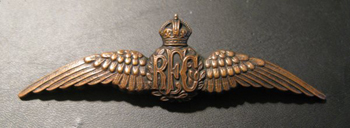
|
|
Width:
Height:
Hallmark:
Pin/Clutch:
Contributor:
Date Added:
Note:
|
Pin
Chris Langley Collection
8/16/2010
"These are original RFC 1913 pilot wings for the field uniform. Even photographs of these in use on field dress are exceptionally rare. They were only in use between Feb 1913 and Feb 1914 when the RFC was a very small body with a very limited number of pilots. When they were replaced in 1914 with the woven badges, apparently many of these badges were simply thrown away as they had developed a bad reputation for tearing uniforms when snagged by belts, coats etc. The long pin bronze wing was most usually found open-backed and had the typical British simple folded wire hinge instead of the bar hinge found on the gilded wings. This wing was used with field service uniform only (and the gilded one was NOT for use with the field service uniform). This badge was approved for use in 1912, came into use in Feb 1913 and was replaced by cloth badges by Feb 1914. The problem with the field service wing was that it was used on the lighter fabric field service jacket and this was worn all the time including when preparing for and completing flight, which meant that it was always catching on straps or clothing and coats and consequently tearing the uniform jacket open along the line of the pin. It was quickly replaced by the wool backed embroidered wing in very early 1914. In Feb 1913 there were two squadrons of aircraft and one balloon unit, so 24-30 aircraft and pilots plus the balloon unit. This badge was VERY rare then and of course most of the pilots were pleased to chuck it away when they got their fabric wings." - Chris Langley
|
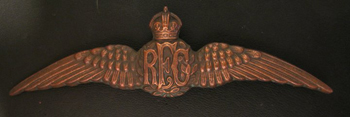
|
|
Width:
Height:
Hallmark:
Pin/Clutch:
Contributor:
Date Added:
Note:
|
Pin
Chris Langley Collection
12/23/2010
"United Kingdon, Royal Flying Corps, Pilot, field dress uniform. Authorized in late 1912, this item is unusually manufactured in bronzed copper. This example is a Firmin production. It was first issued in February 1913 to the very small army flying corps and then fully replaced by February 1914 by woven fabric badges. The first military pilot badge. These metal badges with their pin backs frequently caught on straps and exterior clothing during field use causing tears to uniforms. When replaced with woven badges many metal badges were simply discarded." - Chris Langley
|

|
|
Width:
Height:
Hallmark:
Pin/Clutch:
Contributor:
Date Added:
Note:
|
GJ DF in shield
Pin
12/11/2012
Royal Flying Corps, Pilot, field dress uniform. - This badge was manufactured by Jackson and Fullerton in London. George Jackson and David Fullerton were the proprietors of Joseph Williams & Co from 1884 through 1915. The company itself existed before them and lived on after them as well. The "GJ DF" mark was no longer used after 1915 when George Jackson left the firm.
|
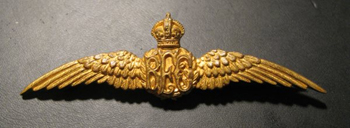
|
|
Width:
Height:
Hallmark:
Pin/Clutch:
Contributor:
Date Added:
Note:
|
Chris Langley Collection
8/16/2010
"This is a sample of the dress uniform and undress uniform wing (same wing, two forms of wear). It is of course gilded and is usually found with either a full plate over the back which would be hard to detect as an add-on if the small gas holes were not present, or with the reverse tips of the wing plated over (the main part being open) with the hinge and hook attached to these partial plates. This wing was brought into use in 1913 and continued in use to 1916 in dress and undress use. It was commonly replaced in 1916 by the bullion type wings though some did continue to wear the gilded wing on dress uniform until the unification of the RFC and the RNAS into the RAF on April 1st 1918." - Chris Langley
|

|
|
Width:
Height:
Hallmark:
Pin/Clutch:
Contributor:
Date Added:
|
Cliff Presley Collection
9/5/2010
|

|
|
Width:
Height:
Hallmark:
Pin/Clutch:
Contributor:
Date Added:
|
JR Gaunt & Son LTD - London
Pin
Chris Langley Collection
1/6/2011
|
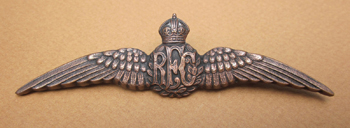
|
|
Width:
Height:
Hallmark:
Pin/Clutch:
Contributor:
Date Added:
Note:
|
J&Co
Pin
Cliff Presley Collection
8/5/2012
1913 Royal Flying Corps metal pilot wings - The original metal Royal Flying Corps (RFC) pilot badge was designed by senior officers General Sir Frederick Hugh Sykes and General Sir David Y. Henderson. It was authorized by Kind George V on February 1, 1913 under Army Order 49/13. The metal badges were phased out in favor of fabric wings in February 1914.
This scarce full size example was die struck in bronze with a hollow back. It has a round metal 'C' catch for the horizontal pin and is hallmarked 'J&Co'. It was manufactured by Joseph Jennens & Co., London, a prestigious maker of high quality Royal military officers' cap-plates, breast-plates, badges and buttons. The company was founded in the early years of the 19th century and changed its name to Jennens & Company, Ltd. in 1913. In 1924 the firm was purchased by J. R. Gaunt & Son who continued to market their products for several years as 'J. R. Gaunt & Son, late Jennens' to emphasize the quality, such was the reputation of Jennens.
Special Note: Authentic metal 1913 RFC pilot wings do not have metal blades that extend out from the back which must be folded flat in order to secure the badge to a uniform; therefore, do not be fooled by the pretense that any badge made like that was meant to be worn.
|

|
|
Width:
Height:
Hallmark:
Pin/Clutch:
Contributor:
Date Added:
|
Pin
Jim Robinson Collection
11/14/2025
|
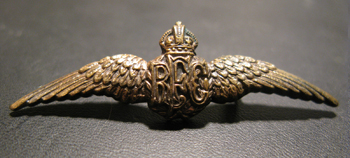
|
|
Width:
Height:
Hallmark:
Pin/Clutch:
Contributor:
Date Added:
Note:
|
Pin & Hook
Chris Langley Collection
1/6/2011
This is the smaller Mess Dress size wing. Click on the photo to see a comparison of the small wing with the full size wing.
|

|
|
Width:
Height:
Hallmark:
Pin/Clutch:
Contributor:
Date Added:
|
Cliff Presley Collection
9/5/2010
|
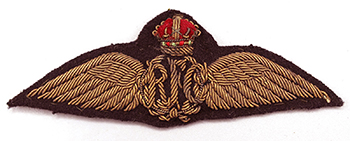
|
|
Width:
Height:
Hallmark:
Pin/Clutch:
Contributor:
Date Added:
|
Cliff Presley Collection
12/30/2020
|

|
|
Width:
Height:
Hallmark:
Pin/Clutch:
Contributor:
Date Added:
Note:
|
Cliff Presley Collection
9/5/2010
This is a dress uniform wing. This is a biographical badge and belonged to Lt. Clarence Albert Mitchell.
|
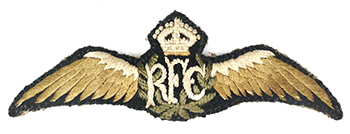
|
|
Width:
Height:
Hallmark:
Pin/Clutch:
Contributor:
Date Added:
|
Tod Rathbone Collection
02/07/2025
|
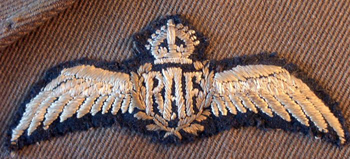
|
|
Width:
Height:
Hallmark:
Pin/Clutch:
Contributor:
Date Added:
Note:
|
Rob Dekker Collection
12/20/2001
Click on the photo of the wing to see the rare tunic it is attached to. It was used just from Apr. 1918 until spring of 1919.
|
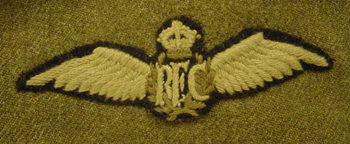
|
|
Width:
Height:
Hallmark:
Pin/Clutch:
Contributor:
Date Added:
|
112 mm
Michael D Long Collection
8/14/2002
|
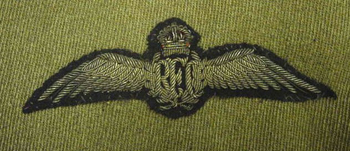
|
|
Width:
Height:
Hallmark:
Pin/Clutch:
Contributor:
Date Added:
|
110 mm
Michael D Long Collection
8/14/2002
|
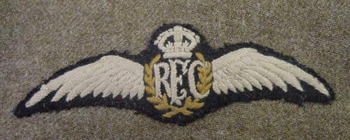
|
|
Width:
Height:
Hallmark:
Pin/Clutch:
Contributor:
Date Added:
|
109 mm
Michael D Long Collection
8/14/2002
|
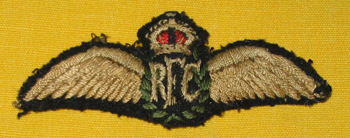
|
|
Width:
Height:
Hallmark:
Pin/Clutch:
Contributor:
Date Added:
Note:
|
Rory Langran Collection
2/10/2005
Royal Flying Corps Pilot
|
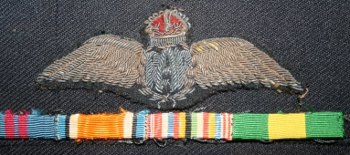
|
|
Width:
Height:
Hallmark:
Pin/Clutch:
Contributor:
Date Added:
Note:
|
Dennis Jackson Collection
5/2/2011
Worn by Lt. Harry C. Dille, American Volunteer, Pilot 34th Squadron - Note Mexican Campaign Ribbon! - April 1918 RAF Blue Uniform
|
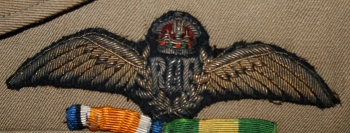
|
|
Width:
Height:
Hallmark:
Pin/Clutch:
Contributor:
Date Added:
Note:
|
Dennis Jackson Collection
5/2/2011
Worn by Harry C. Dille , American Volunteer, 34th Squadron on his Khaki Uniform
|
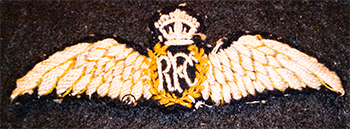
|
|
Width:
Height:
Hallmark:
Pin/Clutch:
Contributor:
Date Added:
Note:
|
The Mel R. E. "mtnman" Collection
11/04/2019
This is a quite rare World War I Royal Flying Corps pilot wing of Middle Eastern origin and design. It is very unusual even for Middle Eastern wing design standards, with a glorious outline design of the fletching, throughout both wings, with the golden brown thread, same used of the wreath which circumscribes the RFC to the center, and a gentle off-white of the brilliantly intertwined Mideast signature threading of the RFC wing fletching. This Wing was likely worn by an RFC pilot on the Salonika front, bringing aid for the Serbs against the Austrians, Bulgarians and Germans or in defense of the Suez canal against the Ottomans.
|
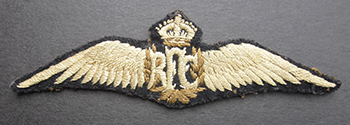
|
|
Width:
Height:
Hallmark:
Pin/Clutch:
Contributor:
Date Added:
|
Cliff Presley Collection
04/06/2020
|
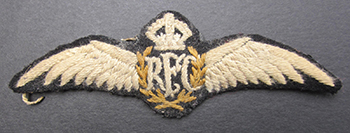
|
|
Width:
Height:
Hallmark:
Pin/Clutch:
Contributor:
Date Added:
|
Cliff Presley Collection
04/13/2020
|
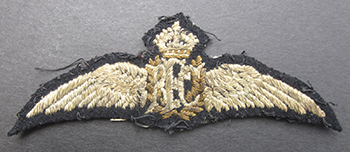
|
|
Width:
Height:
Hallmark:
Pin/Clutch:
Contributor:
Date Added:
Note:
|
Cliff Presley Collection
04/13/2020
This is a biographical badge and belonged to Lt. Clarence Albert Mitchell.
|
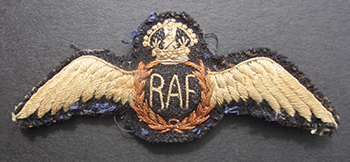
|
|
Width:
Height:
Hallmark:
Pin/Clutch:
Contributor:
Date Added:
Note:
|
Cliff Presley Collection
04/06/2020
This is from WW1 but it is a 1918 Royal Flying Corps/Royal Air Force transitional pilot badge.
|
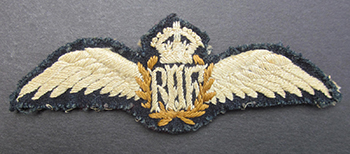
|
|
Width:
Height:
Hallmark:
Pin/Clutch:
Contributor:
Date Added:
Note:
|
Cliff Presley Collection
04/06/2020
This is from WW1 but it is a 1918 Royal Flying Corps/Royal Air Force transitional pilot badge.
|
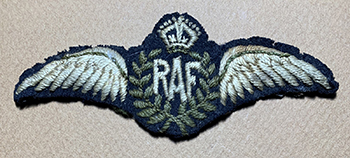
|
|
Width:
Height:
Hallmark:
Pin/Clutch:
Contributor:
Date Added:
Note:
|
Cliff Presley Collection
12/06/2021
This is a 1918 Royal Flying Corps/Royal Air Force transitional pilot badge. It had
been worn on the 1918 U.S. Navy uniform of Ensign Robert Lawrence Piper, Jr.
who first served with the Royal Flying Corps prior to his returning to the USA to
join the U. S. Navy on April 3, 1917. On May 16, 1918 he was designated U. S.
Naval Aviator #667. You can see Ensign Piper's exceedingly rare, early Naval Lighter Than Air badge in the WW1 U.S. Navy section.
|

|
|
Width:
Height:
Hallmark:
Pin/Clutch:
Contributor:
Date Added:
Note:
|
Jim Robinson Collection
03/09/2025
Egyptian made (examples have been found on Egyptian tailored uniforms)
|

|
|
Width:
Height:
Hallmark:
Pin/Clutch:
Contributor:
Date Added:
|
Jim Robinson Collection
03/10/2025
|

|
|
Width:
Height:
Hallmark:
Pin/Clutch:
Contributor:
Date Added:
|
Jim Robinson Collection
03/10/2025
|

|
|
Width:
Height:
Hallmark:
Pin/Clutch:
Contributor:
Date Added:
Note:
|
Jim Robinson Collection
03/10/2025
Theater made variant
|

|
|
Width:
Height:
Hallmark:
Pin/Clutch:
Contributor:
Date Added:
Note:
|
Jim Robinson Collection
03/10/2025
Theater made variant
|

|
|
Width:
Height:
Hallmark:
Pin/Clutch:
Contributor:
Date Added:
|
Jim Robinson Collection
11/14/2025
|

|
|
Width:
Height:
Hallmark:
Pin/Clutch:
Contributor:
Date Added:
|
Jim Robinson Collection
11/14/2025
|

|
|
Width:
Height:
Hallmark:
Pin/Clutch:
Contributor:
Date Added:
|
Jim Robinson Collection
11/14/2025
|

|
|
Width:
Height:
Hallmark:
Pin/Clutch:
Contributor:
Date Added:
|
Jim Robinson Collection
11/14/2025
|

|
|
Width:
Height:
Hallmark:
Pin/Clutch:
Contributor:
Date Added:
|
Jim Robinson Collection
11/14/2025
|

|
|
Width:
Height:
Hallmark:
Pin/Clutch:
Contributor:
Date Added:
|
Jim Robinson Collection
11/14/2025
|

|
|
Width:
Height:
Hallmark:
Pin/Clutch:
Contributor:
Date Added:
|
Jim Robinson Collection
11/14/2025
|

|
|
Width:
Height:
Hallmark:
Pin/Clutch:
Contributor:
Date Added:
|
Jim Robinson Collection
11/14/2025
|

|
|
Width:
Height:
Hallmark:
Pin/Clutch:
Contributor:
Date Added:
|
Jim Robinson Collection
11/14/2025
|

|
|
Width:
Height:
Hallmark:
Pin/Clutch:
Contributor:
Date Added:
|
Jim Robinson Collection
11/14/2025
|

|
|
Width:
Height:
Hallmark:
Pin/Clutch:
Contributor:
Date Added:
|
Jim Robinson Collection
11/14/2025
|

|
|
Width:
Height:
Hallmark:
Pin/Clutch:
Contributor:
Date Added:
|
Jim Robinson Collection
11/14/2025
|

|
|
Width:
Height:
Hallmark:
Pin/Clutch:
Contributor:
Date Added:
|
Jim Robinson Collection
11/14/2025
|

|
|
Width:
Height:
Hallmark:
Pin/Clutch:
Contributor:
Date Added:
|
Jim Robinson Collection
11/14/2025
|

|
|
Width:
Height:
Hallmark:
Pin/Clutch:
Contributor:
Date Added:
|
Jim Robinson Collection
11/14/2025
|

|
|
Width:
Height:
Hallmark:
Pin/Clutch:
Contributor:
Date Added:
|
Jim Robinson Collection
11/14/2025
|

|
|
Width:
Height:
Hallmark:
Pin/Clutch:
Contributor:
Date Added:
|
Jim Robinson Collection
11/15/2025
|

|
|
Width:
Height:
Hallmark:
Pin/Clutch:
Contributor:
Date Added:
|
Jim Robinson Collection
11/15/2025
|

|
|
Width:
Height:
Hallmark:
Pin/Clutch:
Contributor:
Date Added:
|
Jim Robinson Collection
11/15/2025
|

|
|
Width:
Height:
Hallmark:
Pin/Clutch:
Contributor:
Date Added:
|
Jim Robinson Collection
11/15/2025
|

|
|
Width:
Height:
Hallmark:
Pin/Clutch:
Contributor:
Date Added:
|
Jim Robinson Collection
11/15/2025
|

|
|
Width:
Height:
Hallmark:
Pin/Clutch:
Contributor:
Date Added:
Note:
|
Jim Robinson Collection
03/10/2025
J. R. Gaunt 1918 Pattern Observer. Gold plate and silver.
|
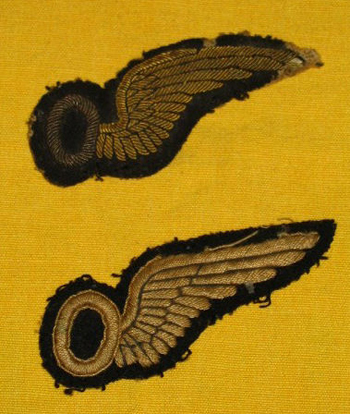
|
|
Width:
Height:
Hallmark:
Pin/Clutch:
Contributor:
Date Added:
Note:
|
Rory Langran Collection
2/10/2005
WWI Royal Flying Corps Observer wings
|
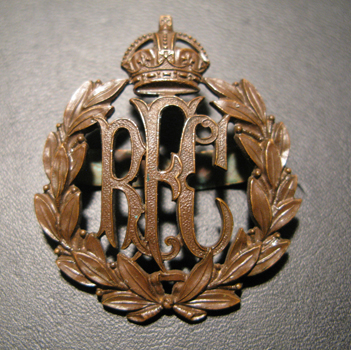
|
|
Width:
Height:
Hallmark:
Pin/Clutch:
Contributor:
Date Added:
Note:
|
Chris Langley Collection
2/5/2011
WWI Royal Flying Corps Cap Badge
|

|
|
Width:
Height:
Hallmark:
Pin/Clutch:
Contributor:
Date Added:
Note:
|
Jim Robinson Collection
03/10/2025
J. R. Gaunt 1918 Pattern Officer Cap Badge. Gold plate and silver.
|